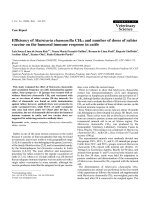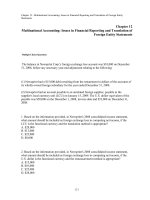Kendall7E ch12
Bạn đang xem bản rút gọn của tài liệu. Xem và tải ngay bản đầy đủ của tài liệu tại đây (816.79 KB, 50 trang )
Designing Effective
Input
Systems Analysis and Design,
7e
Kendall & Kendall
© 2008 Pearson Prentice Hall
12
Learning Objectives
• Design input forms for users of
business systems
• Design engaging input displays for
users of information systems
• Design useful input forms for
people interacting on the Web
• Design useful input pages for users
of intranets and the Internet
Kendall & Kendall
12-2
Input Design Objectives
• The quality of system input determines
the quality of system output
• Input design objectives:
• Effectiveness
• Accuracy
• Ease of use
• Consistency
• Simplicity
• Attractiveness
Kendall & Kendall
12-3
Major Topics
• Input design
• Form design
• Display design
• GUI screen design
• GUI controls
• Web design guidelines
Kendall & Kendall
12-4
Good Form Design
• Make forms easy to fill in
• Ensure that forms meet the
purpose for which they are
designed
• Design forms to assure accurate
completion
• Keep forms attractive
Kendall & Kendall
12-5
Make Forms Easy to Fill in
• Form flow
• Seven sections of a form
• Captioning
Kendall & Kendall
12-6
Form Flow
• Can minimize the time and effort
expended by employees in form
completion
• Should flow from left to right and
top to bottom
Kendall & Kendall
12-7
Seven Sections of a Form
• Heading
• Identification and access
• Instructions
• Body
• Signature and verification
• Totals
• Comments
Kendall & Kendall
12-8
Figure 12.1 Seven sections
found in well-designed forms
Kendall & Kendall
12-9
Caption Types
• Line caption
•
•
•
•
•
• Putting the caption on the same line or below the line
Boxed caption
• Providing a box for data instead of a line
Check off caption
• Lining up choices or alternatives vertically
Horizontal check off caption
• Lining up choices or alternatives horizontally
Table caption
• Work well in the body of a form
Combination
Kendall & Kendall
12-10
Figure 12.2 Major captioning
alternatives
Kendall & Kendall
12-11
Meeting the Intended
Purpose
• Systems analysts may use
different types of specialty forms
for different purposes
• Specialty forms
• Multiple-part
• Continuous-feed
• Perforated
Kendall & Kendall
12-12
Ensuring Accurate
Completion
• To reduce error rates associated
with data collection, forms should
be designed to assure accurate
completion
• Design forms to make people do
the right thing with the form
Kendall & Kendall
12-13
Keeping Forms Attractive
• Aesthetic forms draw people into
them and encourage completion
• Forms should look uncluttered, and
elicit information in the expected
order
• Using different fonts and line weights
within the same form can help make
it more attractive for users
Kendall & Kendall
12-14
Computer-Assisted Form
Design
• Numerous form design packages
are available for PCs
• Electronic forms can have
intelligence that supports users in
their tasks
Kendall & Kendall
12-15
Figure 12.4 Software for electronic
form design has many dynamic
features
Kendall & Kendall
12-16
Figure 12.5 Omniform from ScanSoft allows the user to
take an existing form, scan it into the computer, and define
fields so the form can be easily filled out on a PC
Kendall & Kendall
12-17
Controlling Business Forms
• Making sure that each form in use fulfills its
•
•
•
•
•
specific purpose
Making sure that the specified purpose is
integral to organizational functioning
Preventing duplication of information collected
and of the forms that collect it
Designing effective forms
Deciding on how to reproduce forms in the
most economical way
Establishing procedures that make forms
available, at the lowest possible cost
Kendall & Kendall
12-18
Good Display and Web Forms
Design
• Keep the display simple
• Keep the display presentation
consistent
• Facilitate user movement among
display screens and pages
• Create an attractive and pleasing
display
Kendall & Kendall
12-19
Keeping the Display
Simple
• Heading
• Body
• Comments and instructions
Kendall & Kendall
12-20









